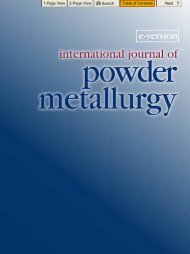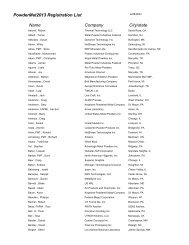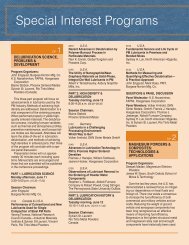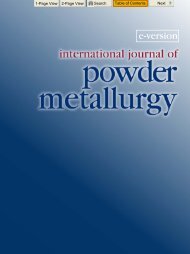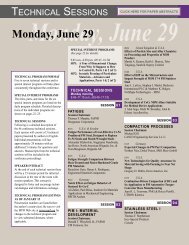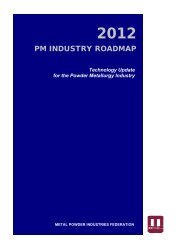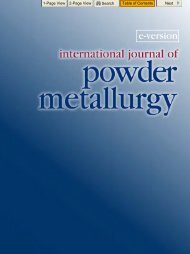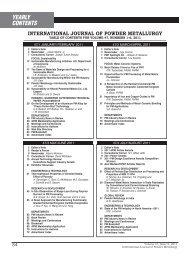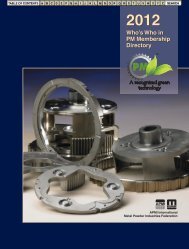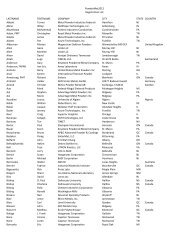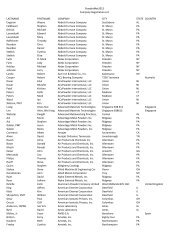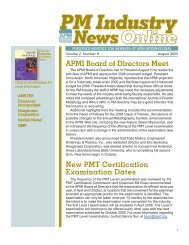E-IJPM: Vol. 44/4 - MPIF
E-IJPM: Vol. 44/4 - MPIF
E-IJPM: Vol. 44/4 - MPIF
You also want an ePaper? Increase the reach of your titles
YUMPU automatically turns print PDFs into web optimized ePapers that Google loves.
stearate was used as a die-wall lubricant, but the<br />
aluminum powder per se was not lubricated.<br />
Powder Extrusion<br />
Extrusion tests were carried out on the 15.97<br />
mm dia. precompacted aluminum powder billets<br />
using a die with an orifice dia. of 11.07 mm, corresponding<br />
to an extrusion ratio of 2.1. Prior to<br />
extrusion the powder billets were compacted in a<br />
die, which later was used as a container during<br />
the extrusion process. This low extrusion ratio<br />
was chosen to permit analysis of the densification<br />
of the powder billets during extrusion as a function<br />
of ram displacement and is much lower than<br />
the recommended values of 9 or higher for complete<br />
densification of spherical powders.8<br />
Extrusion was carried out at room temperature<br />
(25°C) at an extrusion (ram) speed of 30 mm/min.<br />
The die at the end of the extrusion container was<br />
replaced with a flat plate assembly which allowed<br />
the extrusion container to be used as a compaction<br />
die.<br />
The interparticle friction within the powder billet<br />
depends on particle size, particle shape, and<br />
surface texture. Therefore, it is important to<br />
determine at which point billet densification is<br />
complete for the different powder morphologies.<br />
Since the precompacted billets were uniaxially<br />
compacted in the extrusion container, they exhibited<br />
a region of high density (low porosity) at the<br />
ram end (at which the pressure was applied),<br />
while the other end of the billet exhibited a region<br />
of lower density (higher porosity). As a result, the<br />
end of the billet with lower density (higher porosity)<br />
was towards the extrusion die. The extrusion<br />
Figure 2. Extent of extrusion with corresponding % ram displacement of initial<br />
billet length<br />
<strong>Vol</strong>ume <strong>44</strong>, Issue 4, 2008<br />
International Journal of Powder Metallurgy<br />
CONSOLIDATION OF ALUMINUM POWDER DURING EXTRUSION<br />
tests were preformed with flat-face dies (halfincluded<br />
angle of 90°) with a round die orifice and<br />
a 3 mm-long bearing length.<br />
Extrusion tests were performed on a 3 MN vertical<br />
hydraulic press. The extrusion process was<br />
arrested at ram positions of 12%, 23%, 33%, <strong>44</strong>%,<br />
58%, 70%, 83%, and 99% of the initial billet<br />
length from the end surface of the precompacted<br />
billets (40 mm). The extent of extrusion, with<br />
respect to ram displacement, is shown schematically<br />
in Figure 2. Extrusion ram pressure and<br />
ram displacement data were collected directly<br />
from the load cell and displacement sensors. The<br />
Figure 3. Extrusion pressure vs. ram displacement curves as a function of ram<br />
displacement. Aluminum powder grade AM 603<br />
Figure 4. Extrusion pressure vs. ram displacement curves as a function of ram<br />
displacement. Aluminum powder grade AM 605<br />
29



